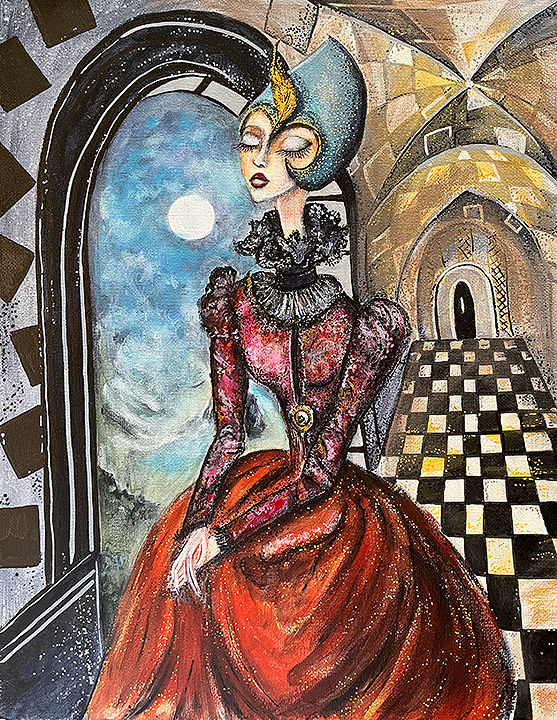What Is Museum-Quality Aesthetics?
- Natalia Lakes

- May 24
- 3 min read

What defines a painting as museum-worthy? Is it merely the technical prowess? The originality of its vision? Or is it the psychological depth that leaves us changed?
Let us consider The Dream Within the Corridor as a living example: a surrealist composition where Renaissance elegance merges seamlessly with metaphysical intrigue.
She sits at the threshold between worlds—poised, yet unreachable. Her stillness hums with hidden tension. Draped in vermilion silk and crowned with a mythic headpiece, the woman gazes inward, moved by the moonlight spilling through an arched window behind her. The corridor extends infinitely, its golden arcades refracting time like glass.
This is no ordinary portrait. It is a metaphysical riddle. The artist invokes the visual grammar of the Renaissance—voluminous gown, chiaroscuro modeling, ecclesiastical architecture— only to distort it with a surrealist twist.
1. Narrative Density: The Architecture of Symbolism
Museum-quality work does not merely depict—it suggests. This painting contains a layered narrative, constructed not through explicit storytelling, but through symbolic architecture and psychological posture.
The checkerboard floor evokes the dualities of existence: light and dark, known and unknown. The receding corridor hints at metaphysical infinity, echoing the spatial riddles of de Chirico, where time becomes depth and the viewer becomes the wanderer.
To the left, a full moon casts cold light into an otherwise warm palette—perhaps mirroring the woman’s interior landscape. She is both present and distant, suspended between two thresholds: the inner self and the outer cosmos. Her posture, poised yet self-contained, speaks of introspection.
This density of interpretation is a hallmark of museum-worthy work: the painting continues to unfold long after its initial encounter.
2. Technical Mastery: The Fusion of Classical and Contemporary
The artist’s command of mixed media textures and chiaroscuro reflects classical training, yet the surreal proportions and stylized features clearly diverge from naturalism. Her elongated neck and mask-like face recall the refined distortions of Modigliani and Leonor Fini. The dress is not merely fabric—it is form, sculpted with baroque grandeur and contemporary abstraction.
A collector attuned to museum aesthetics will notice the tension between historic homage and postmodern reinvention. This is not pastiche. This is synthesis: the old language spoken with a new accent.
3. Atmosphere and Mood: A Dream Logic
Truly great paintings emit an atmosphere that cannot be paraphrased. In this piece, light does not fall—it emanates. The palette walks the tightrope between jewel-toned luxury and moody restraint: carmine, obsidian, ochre, and lunar blue all converse across the canvas like a hidden code.
This kind of atmosphere is not accidental. It signals the presence of a painter who understands how to orchestrate emotional resonance through visual means. Such mood-making elevates a painting from decoration to experience.
4. Intellectual Ambiguity: The Power of the Unresolved
Museum pieces are not designed to be solved. They do not flatter the viewer’s intellect—they provoke it. This figure is regal, yet anonymous. Powerful, yet contemplative. Her garb suggests theater, ritual, or myth, but her gaze is deeply human. Is she waiting? Guarding? Remembering?
That ambiguity creates room for projection. Museum-worthy art engages the viewer as a participant, not just a spectator. The mystery of this painting is not a puzzle to solve—it is a mirror to enter.
5. Timelessness and Placement: A Work that Transcends Trends
One of the clearest signs of museum-quality art is its independence from trend. This work is not catering to fleeting taste; it is building its own visual language. The surreal architecture, the symbolic landscape, and the figure’s eternal quality place it outside the logic of seasons and market fads.
In a home, such a piece transforms a room into a sanctuary. In a collection, it anchors a narrative. In a museum, it converses with centuries. Its placement does not limit it—it expands it.
Final Thought: Cultivating the Collector’s Eye
To appreciate a work like this is to sharpen one’s instinct as a collector. Museum-quality work rewards time, attention, and thought. It does not simply "look good"—it creates a field of meaning around itself. It enhances the room, but more importantly, it enlarges the viewer.
In a world increasingly driven by speed and superficiality, paintings like this resist reduction. They whisper of a slower, stranger intelligence—one that invites, but never demands.This is not merely art. This is philosophy, translated into pigment.


